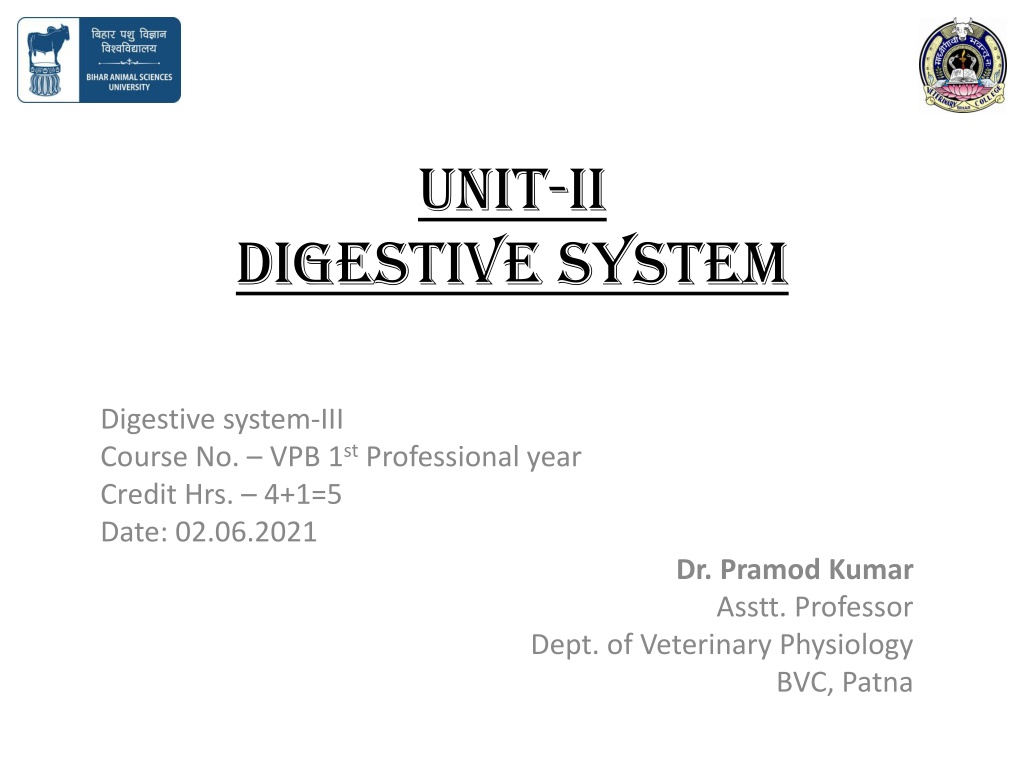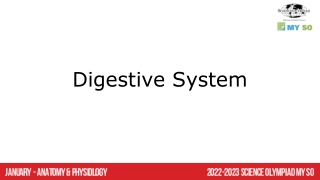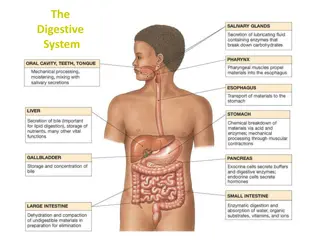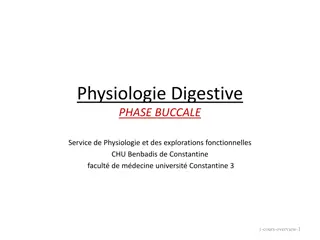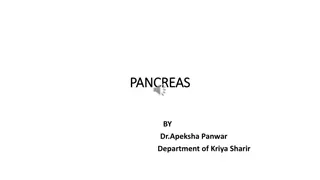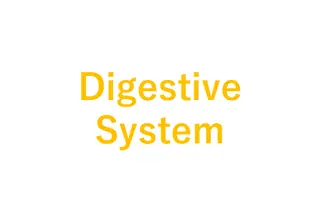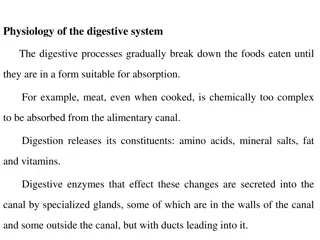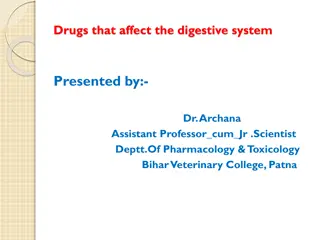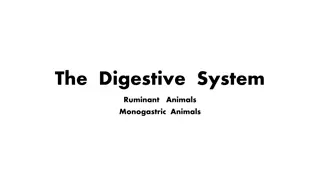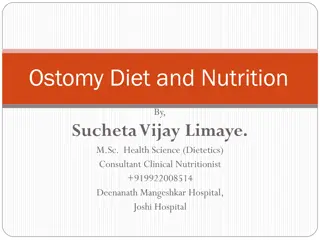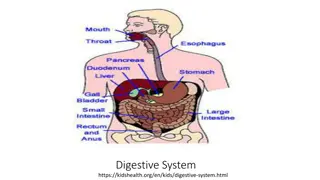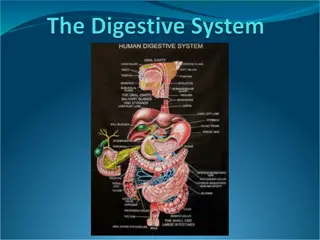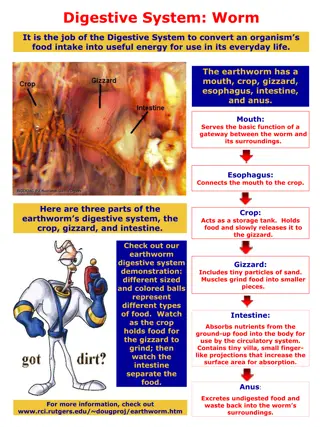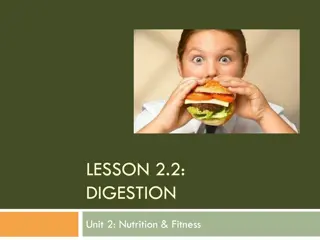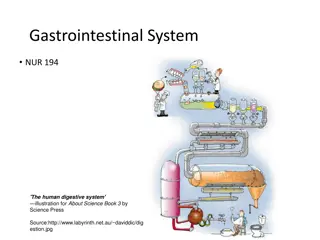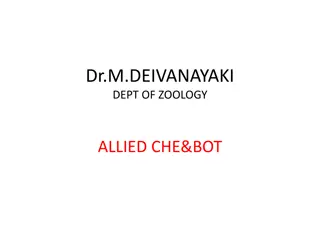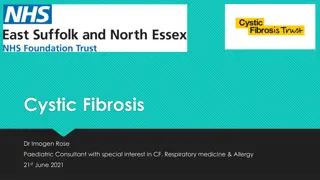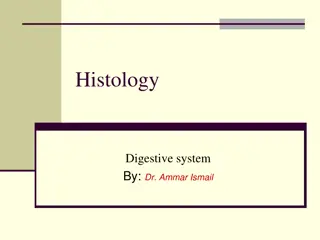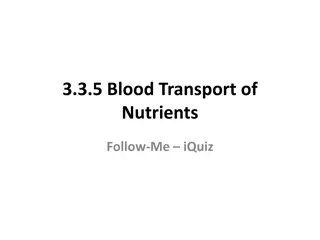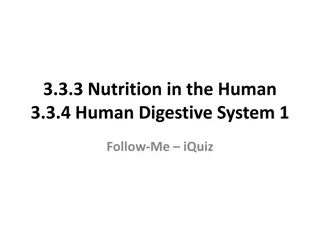UNIT-II Digestive System
Pancreatic secretions play a crucial role in the digestion process, regulated through cephalic, gastric, and intestinal phases. The composition includes electrolytes and enzymes essential for breaking down carbohydrates, proteins, and fats. Failure to neutralize chyme can lead to issues like duodenal ulcers in the upper intestine.
Download Presentation

Please find below an Image/Link to download the presentation.
The content on the website is provided AS IS for your information and personal use only. It may not be sold, licensed, or shared on other websites without obtaining consent from the author.If you encounter any issues during the download, it is possible that the publisher has removed the file from their server.
You are allowed to download the files provided on this website for personal or commercial use, subject to the condition that they are used lawfully. All files are the property of their respective owners.
The content on the website is provided AS IS for your information and personal use only. It may not be sold, licensed, or shared on other websites without obtaining consent from the author.
E N D
Presentation Transcript
Unit-II Digestive System Digestive system-III Course No. VPB 1stProfessional year Credit Hrs. 4+1=5 Date: 02.06.2021 Dr. Pramod Kumar Asstt. Professor Dept. of Veterinary Physiology BVC, Patna
Pancreatic secretions: Regulation- Pancreas secretion is divided into three phases Cephalic phase:- Thought, sight, smell or taste of food produces the cephalic phase of pancreatic secretion. Enzyme secreted by the acinar cells are stimulated by enteric neurons releases from ACh (vagal stimulation) HCO3-secreted by ductal cells stimulated by vagus nerves releases a non-cholinergic & non-adrenergic transmitter Gastric phase:- This phase is enhanced during the distension & food breakdown products. Distension leads to secretion of HCO3-& enzymes through ACh (Antrum & corpus). When food breakdown occurs G-cells of the antrum releases gastrin, produces a low volume & high enzyme pancreatic secretion Intestinal phase:- Major stimulants for pancreatic secretion are the hormones CCk & secretin. They are released from endocrine cells in the duodenum & jejunum. Both CCk & secretin along with potentiate the secretion of HCO3-& produce in significant amount
Composition- Pancreatic secretion consists of electrolytes & enzymes Electrolytes: Na+& K+, HCO3-& H+from the dissociated of H2CO3. It also contains small amounts of Ca2+, Mg2+, Zn2+, HPO42-(mono-hydrogen phosphate) & SO42-(sulfate) Enzymes: It consists of -amylase which hydrolyzes glycogen, starch to disaccharides except cellulose in carbohydrate. Water soluble esters can be hydrolyzed through pancreatic lipases. trypsinogen is converted to trypsin by enterokinase. Functions- The endocrine cells secrete insulin, glucagon, somatostatin & pancreatic polypeptide. The exocrine cells into acini produces 4 types of digestive enzyme peptidases, lipases, amylases & nucleases, which are responsible for the digestion of proteins, fats, carbohydrates & nucleic acids respectively. Trypsinogen & chymo-
The ductal cells consist of high concentration of HCO3- which neutralizes gastric acid & regulates the pH of upper intestine Failure to neutralize the chyme & undergoes to intestine can cause duodenal ulcers. Digestion in the ruminant stomach: Ruminant stomach have microbial fermentation of the ingesta by hydrolysis & anaerobic oxidation Microbes generate ATP fermentation to absorb the end products i.e., VFA but in case of non ruminants, it is glucose Ruminant stomach is highly vascularized & blood flow es when the absorption of end products are being going on The innervations are by vagal & splanchnic nerves provides sensory & motor pathways for further hydrolysis &
Mechanism of absorption of carbohydrates, protein & fat: Ruminal microbes consists of yeast, fungi & mixed but independent population of bacteria CH2O in diet mainly consists of starch, sucrose, lactose & fiber In the lumen, pancreatic -amylase combines disaccharides & tri-glysaccharides & -limit dextrins Intra-luminal products of CH2O digestion with the dietary disaccharides can`t be absorbed by the mucosa It further breakdown into transported into the epithelial cells by Na-dependent co- transport & facilitated diffusion process & enters into the blood stream Protein hydrolysis begins in stomach but digestion occurs in proximal small intestine mono-saccharides being
Amino acids, di-peptides & tri-peptides are the remaining products after pancreatic digestion Peptides are further hydrolsed by brush border hydrolases (junction between intestinal lumen & cytoplasm) 10% of peptides escape hydrolysis & diffuse to baso-lateral membrane having neuro-active properties contains non nutritional value Amino acids are absorbed by Na-dependent co-transport & diffuse across the baso-lateral membrane into the portal vein Dietary fat consists of water insoluble triglycerides, emulsified in the stomach In duodenum, pancreatic lipase acts at oil-water interface of the emulsion particles releasing -monoglycerides & 2 free fatty acids (amphipaths) Bile salts act as detergent & bring the water insoluble into micelle & get dissolved into micelle core in jejunum
Amphipaths- part polar-water insoluble & non polar-lipid soluble Micelle (-vely charged aggregates)- to form micelles, need of bile acids & 2mM Micelles diffuse from the emulsion particle to the brush border where fat releases for diffusion across the lipid membrane into cell Fat soluble vitamins can incorporated into micelle Chylomicrons facilitate the transport of water insoluble triglycerides & without protein coat, fat is unable to leave the cell only be absorbed when
Cellular fermentative digestion- Due to low metabolic rate of cellulolytic bacteria, slow fermentation occurs The pH optimum is 6.2 to 6.8 of cellulolytic bacteria (methanogenic bacteria) It requires CO2& 2H (reducing equivalents) supplies to produce methane & amino acids supply to get their protein requirements These mixed microbes leads to produce VFA, CO2& CH4 Fermentative digestion of Starch: Starch & simple sugar degradation is performed by various primary amylolytic bacteria These bacteria`s have faster fermentative rates & low pH optimum 5.5 to 6.6 These bacteria`s require NH3& amino acid for synthesis of protein
Fermentative digestion of Protein: Proteolytic bacteria degrades 15 to 35% of dietary protein in the rumen Bacterial proteolysis produce peptides which are absorbed & further hydrolyze within the cell of bacteria End products are amino acids taken up by some other microbes & rest are used to produce ammonia & certain metabolic acids These end products are further fermented to VFA`s required as nutrition for cellulolytic bacteria After conversion of dietary & NPN compounds & de- amination, results in production of ammonia Ammonia is an important substrate for microbial protein synthesis to provide the energy needed for the synthetic reaction During fermentation of dietary protein, recycling of dead microbes protein is continues
Fermentative digestion of Lipids: Ruminal microbes hydrolyze dietary lipids, using the unsaturated fatty acids as hydrogen acceptors which converts mostly into stearic acid From VFA`s ruminal microbes synthesize microbial lipids Protozoa absorb few of poly-unsaturated fatty acids (PUFA) in their own structure to protect them from hydrogenation During intestinal digestion, the protozoa`s which comes from the rumen, release their content of PUFA as the main source for ruminants Absorption of food stuffs: VFA`s- It is absorbed by passive diffusion through the granulosum cells of the fore-stomach epithelium Lactic acid- It is also absorbed by fore-stomach epithelium
